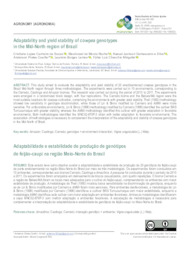Adaptability and yield stability of cowpea genotypes in the Mid-North region of Brazil.
Adaptability and yield stability of cowpea genotypes in the Mid-North region of Brazil.
Author(s): SOUZA, C. L. C. de; ROCHA, M. de M.; SILVA, K. J. D. e; COELHO, A. P.
Summary: This study aimed to evaluate the adaptability and yield stability of 20 erect/semierect cowpea genotypes in the Brazil Mid-North region through three methodologies. The experiments were carried out in 10 environments, corresponding to the Cerrado, Caatinga and Amazon biomes. The research was carried out during the period of 2010 to 2011. The experiments were arranged in a randomized block design, with four replications. The Cerrado biome and the Balsas/MA region were the most suitable locations for cowpea cultivation, comprising the environments with greater yield stability. Theil (1950) methodology showed low sensitivity in genotype discrimination, while those of Lin & Binns modified by Carneiro and AMMI were more sensitive. For unfavorable environments, Lin & Binns (1998) methodology modified by Carneiro (1998) identified the cultivar BRS Tumucumaque with greater stability, whereas the AMMI methodology identified this cultivar with greater adaptation in favorable environments. Both methodologies identified the MNC02-676F-3 strain with better adaptation to favorable environments. The association of methodologies is necessary to complement the interpretation of the adaptability and stability of cowpea genotypes in the Mid-North of Brazil.
Publication year: 2022
Types of publication: Journal article
Unit: Embrapa Mid-North
Keywords: Amazonia, Caatinga, Cerrado, Interação genótipo × ambiente, Vigna Unguiculata
Observation
Some of Embrapa's publications are published as ePub files. To read them, use or download one of the following free software options to your computer or mobile device. Android: Google Play Books; IOS: iBooks; Windows and Linux: Calibre.
Access other publications
Access the Agricultural Research Database (BDPA) to consult Embrapa's full library collection and records.
Visit Embrapa Bookstore to purchase books and other publications sold by Embrapa.

